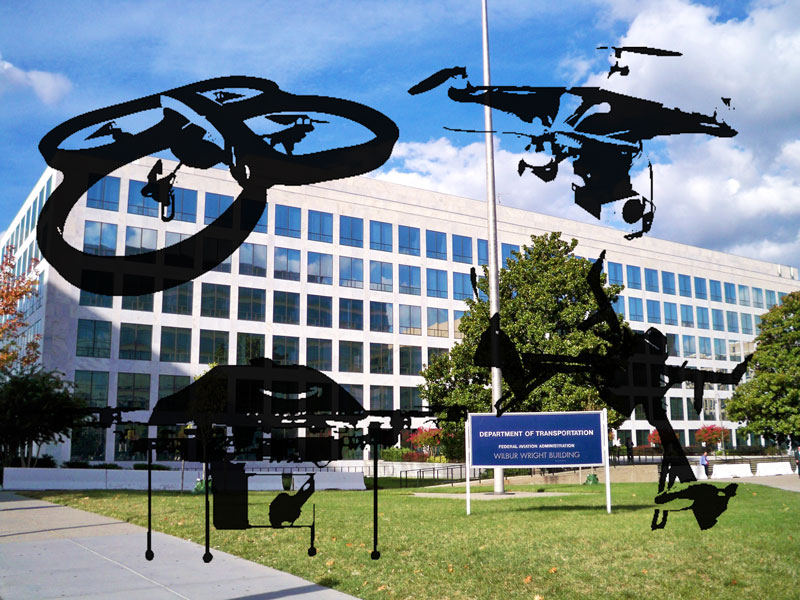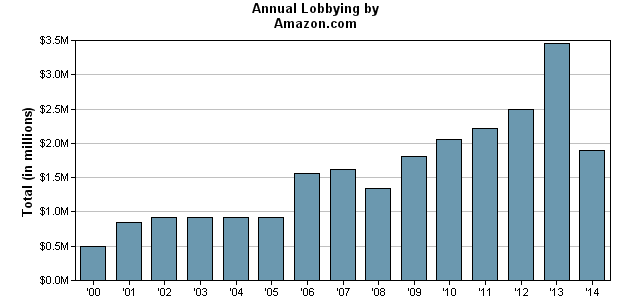
Robohub.org
Does the Small UAV industry need its own coalition?
 Last week USA Today reported that Amazon, 3D Robotics, Parrot and DJI had banded together to form a “Small UAV Coalition”, hiring DC-based lobbying firm Akin Gump to represent their interests before US regulators and ease the way for the commercial drone industry in that country. Akin Gump lobbyist Michael Drobac says that, since the USA Today report was first published, Airware and GoPro have joined the fold and others in the small UAV business will soon be following suit. But does the small UAV industry need its own lobbying effort, and how will the inclusion of retail giant Amazon impact its ability to represent the broader group?
Last week USA Today reported that Amazon, 3D Robotics, Parrot and DJI had banded together to form a “Small UAV Coalition”, hiring DC-based lobbying firm Akin Gump to represent their interests before US regulators and ease the way for the commercial drone industry in that country. Akin Gump lobbyist Michael Drobac says that, since the USA Today report was first published, Airware and GoPro have joined the fold and others in the small UAV business will soon be following suit. But does the small UAV industry need its own lobbying effort, and how will the inclusion of retail giant Amazon impact its ability to represent the broader group?
In addition to contending with the FAA, the group must also gain traction with the Federal Communications Commission (FCC), which manages the communication frequencies that drones would use, and the White House Office of Science and Technology Policy, which will be ruling on privacy issues. With multiple government bodies to lobby, Drobac believes it makes sense to work together in a concerted effort.
According to Drobac, there was already an appetite for a coalition among those in the small UAV business, whose needs differed somewhat from the larger UAV firms with aerospace and defence contracts. “The coalition members are all extremely consumer-focused,” he said, pointing out that the first priority of the group will be to lobby for clear safety and privacy guidelines, both of which are key concerns for consumers. The coalition has already filed several petitions for exemption with the FAA, and hopes to influence and educate policymakers and consumers about the commercial opportunities of small UAVs.
According to the Center for Responsive Politics:
“Companies with drone aircraft currently used by the military, but with potential civilian applications, were among the largest donors to US caucus members.”
Those firms include:
BAE Systems (Mantis and Taranis drones)
Boeing Co.(Phantom Eye)
Honeywell International (RQ-16 T-Hawk)
Lockheed Martin (RQ-170 Sentinel)
Raytheon Co. (Cobra)
General Atomics (Predator)
Patrick Egan from sUAS News thinks this consumer focus makes the coalition’s lobbying needs distinctly different from the needs of the UAV “old guard” of Department of Defence (DoD) vendors. “Previous lobbying efforts have been working to regulate 10-year-old aviation technology,” he says, pointing out that, by contrast, members of the Small UAV Coalition want to invest in new technology and new applications that haven’t even been discovered yet, and for that they will need extremely broad and inclusive regulatory definitions.
It therefor matters that they have their own representation. “If you’ve successfully lobbied to have the standards built around your product or business needs, you will have an edge,” says Egan, pointing out that while current regulations tend to focus on the fixed wing products common to DoD vendors, the regulations don’t even consider the multirotor devices that are common to the small UAV industry right now.
Image is another factor that may be drawing the coalition together. “A lot of small UAV companies have avoided aligning themselves with DoD vendors because of their military focus,” says Egan. “They just don’t need the controversy.”
Amazon retained council from Akin Gump when it filed its petition for exemption with the FAA this past July to begin tests with drones that weigh less than 55 pounds and fly below 400 feet. In its letter to the FAA, Amazon said that so far it has only been able to test its drones inside its Seattle R&D lab or in other countries, but would “prefer to keep the focus, jobs, and investment of this important research and development initiative in the United States by conducting private research and development operations outdoors near Seattle – where our next generation R&D lab and distinguished team of engineers, scientists and aeronautical professionals are located.”
Earlier this week, the Economic Times rumored that Amazon will begin testing drone delivery in India. If true, Amazon is pulling all punches. The threat of losing talent, R&D and investment to other countries is one of the key arguments of commercial drone advocates in the US. Andra Keay of Silicon Valley Robotics says, “Going to India sends a strong message to the FAA, and it makes so much sense. India is well-known for the high calibre of their roboticists, engineers and developers. And yet parts of the country still have very rudimentary infrastructure, which actually makes it easier to do disruptive innovation there. It’s harder to patch existing legacy building and transport technologies than it is to start afresh.”
Drobac says that allowing private testing facilities is key to keeping UAV innovation in the US: “Sure the FAA has some test sites, but it’s much more pragmatic to have testing near to where your headquarters are.”
For companies that are pushing innovation in this space, distance is not the only issue with testing facilities. New technologies such as sense-and-avoid will need to be peer reviewed to meet (as-yet unspecified) safety regulations, and private companies like Amazon don’t want to go to public testing facilities. Says Egan: “Even though they might need an independent 3rd party to review their safety record, they still want to keep their proprietary data safe. We don’t know how safe that data is at a public site.”
The high cost of using the FAA testing sites (according to Egan, $5-10K per day) presents another obstacle. “I’m not sure that the FAA took into account how prohibitive these costs could be to a small company that is just getting off the ground,” said Egan. “This is really a hold-over from the days when most UAV operators were Department of Defence vendors.”
According to the US Center for Responsive Politics, a non-partisan organization that tracks lobbying expenditures in the US, Amazon has significantly increased its lobbying expenditures in recent years (see chart). In the USA Today article, Chris Anderson from 3D Robotics was quoted as saying that Amazon’s interest “lets people realize how big it can be … They have a well-established presence in Washington and they were able to kick-start the mechanics of this coalition so we could quickly join and get moving.”

Egan agrees that the influence of a big player is critical to the future success of the coalition, saying that “Amazon has a lot of horsepower and the White House has now renewed its interest in the issue,” however he points out that in the longer term it could be difficult for companies with such different applications and financial resources to keep their interests aligned.
Drobac could not comment on the price of entry for joining the coalition, and would not speculate on how much money would have to be spent to smooth the way for the small UAV industry in the US. “It’s not about how much money will be required to change lawmakers’ minds, ” he said. “The question will come down to whether we can educate people about the tremendous benefits of UAVs to society, and we’re confident that we will because technology always wins.”
So far in 2014, Amazon has spent $40K on lobbying for Prime Air – a number that is likely to increase now that the coalition is official.
Whatever future challenges may exist between coalition members, Drobac insists that their focus will be on their common objective of opening up US airspace to small commercial UAVs: “If we can crack that door open, all boats will rise.”
“I just hope they don’t get frustrated at the pace the FAA operates at,” says Egan, who has been advocating for commercial UAVs for over ten years. “The movement towards the integration of US airspace has been slower than glacial.”
tags: 3D Robotics, Airware, Amazon, c-Aerial, cx-Politics-Law-Society, DJI, drone regulation, FAA, Parrot, Small UAV Coalition


